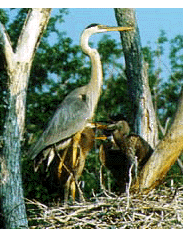Several great blue herons have been seen by Christine Morin during the summer of 2000. She observed them throughout the summer and concluded they were probably using the entire water system of the property when searching for prey.
 Great
blue herons, which actually have a back which is grayish-blue in
color, are large, elegant wading birds which inhabit marshes and
swamp-like areas.
Great
blue herons, which actually have a back which is grayish-blue in
color, are large, elegant wading birds which inhabit marshes and
swamp-like areas.
They are about 4 feet tall and have a wingspan of about six feet. They stand on their long legs in watery surroundings with their head erect or folded on their shoulders. They strike rapidly with their long spearlike bill to catch fish, snakes, frogs, grasshoppers and other small animals.
The birds are quite conspicuous when they take flight due to their lengthy wingspan and their gangly legs trailing behind them. The heron's long neck is folded during flight.
The great blue heron is a sociable species and during the breeding season, herons join with other herons to form colonies,or rookeries, in woodlands that are near their main feeding area, but relatively inaccessible to humans or land predators. Here,they build huge nests made of large sticks. The nests are located high in the branches of deciduous trees. Herons often return to the same locality each year, and the same nest may be used year after year.
Herons are very sensitive to any type of disturbance while they are nesting. It is suggested that there be no development near the edge of a heron colony and no disturbance in or near colonies from March to August.
The great blue heron may live as long
as 17 years, since adult birds have few natural enemies. However they
are threatened by draining of marshes and destruction of other
favorite haunts.
Credits: The photograph of the Great Blue Heron appeared at one
time on the Wisconsin Department of Natural Resources Web
Site.